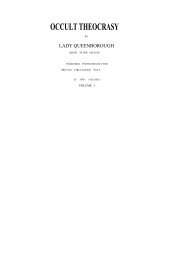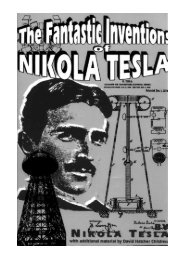the fantastic inventions of nikola tesla - Exopolitics Hong Kong
the fantastic inventions of nikola tesla - Exopolitics Hong Kong
the fantastic inventions of nikola tesla - Exopolitics Hong Kong
You also want an ePaper? Increase the reach of your titles
YUMPU automatically turns print PDFs into web optimized ePapers that Google loves.
wound tightly around <strong>the</strong> rod, and a highly polished tube <strong>of</strong> one or three layers <strong>of</strong> <strong>the</strong> sheet is obtained. When<br />
slipped on <strong>the</strong> stem, <strong>the</strong> pressure is generally sufficient to prevent it from slipping <strong>of</strong>f, but, for safety, <strong>the</strong> lower<br />
edge <strong>of</strong> <strong>the</strong> sheet may be turned inside. The upper inside corner <strong>of</strong> <strong>the</strong> sheet—that is, <strong>the</strong> one which is nearest to <strong>the</strong><br />
refractory incandescent body —should be cut out diagonally, as it <strong>of</strong>ten happens that, in consequence <strong>of</strong> <strong>the</strong> intense<br />
heat, this corner turns toward <strong>the</strong> inside and comes very near to, or in contact with, <strong>the</strong> wire, or filament, supporting<br />
<strong>the</strong> refractory body. The greater part <strong>of</strong> <strong>the</strong> energy supplied to <strong>the</strong> bulb is <strong>the</strong>n used up in heating <strong>the</strong> metal tube,<br />
and <strong>the</strong> bulb is rendered useless for <strong>the</strong> purpose. The aluminium sheet should project above <strong>the</strong> glass stem more or<br />
less—one inch or so—or else, if <strong>the</strong> glass be too close to <strong>the</strong> incandescing body, it may be strongly heated and<br />
become more or less conducting, whereupon it may be ruptured, or may, bv its conductivity, establish a good<br />
electrical connection between <strong>the</strong> metal tube and <strong>the</strong> leading-in wire, in which case, again, most <strong>of</strong> <strong>the</strong> energy will<br />
be lost in heating <strong>the</strong> former. Perhaps <strong>the</strong> best way is to make <strong>the</strong> top <strong>of</strong> <strong>the</strong> glass tube. for about an inch, <strong>of</strong> a much<br />
smaller diameter. To still fur<strong>the</strong>r reduce <strong>the</strong> danger arising from <strong>the</strong> heating <strong>of</strong> <strong>the</strong> , glass stem, and also with <strong>the</strong><br />
view <strong>of</strong> preventing an electric- ; al connection between <strong>the</strong> metal tube and <strong>the</strong> electrode, T preferably wrap <strong>the</strong> stem<br />
with several layers <strong>of</strong> thin mica, which extends at least as far as <strong>the</strong> metal tube. In some bulbs I have also used an<br />
outside insulating cover.<br />
The preceding remarks are only made to aid <strong>the</strong> experimenter in <strong>the</strong> first trials, for <strong>the</strong> difficulties which he encounters<br />
he may soon find means to overcome in his own way.<br />
To illustrate <strong>the</strong> effect <strong>of</strong> <strong>the</strong> screen, and <strong>the</strong> advantage <strong>of</strong> using it, I have here two bulbs <strong>of</strong> <strong>the</strong> same size, with <strong>the</strong>ir<br />
stems, leading-in wires and incandescent lamp filaments tied to <strong>the</strong> latter, as nearly alike as possible. The stem <strong>of</strong><br />
one bulb is provided with an aluminium tube, <strong>the</strong> stem <strong>of</strong> <strong>the</strong> o<strong>the</strong>r has none. Originally <strong>the</strong> two bulbs were joined<br />
by a tube which was connected to a Sprengel pump. When a high vacuum had been reached, first <strong>the</strong> connecting<br />
tube, and <strong>the</strong>n <strong>the</strong> bulbs, were sealed <strong>of</strong>f; <strong>the</strong>y are <strong>the</strong>refore <strong>of</strong> <strong>the</strong> same degree <strong>of</strong> exhaustion. When <strong>the</strong>y are<br />
separately connected to <strong>the</strong> coil giving a certain potential, <strong>the</strong> carbon filament in <strong>the</strong> bulb provided with <strong>the</strong><br />
aluminium screen is rendered highly incandescent, while <strong>the</strong> filament in <strong>the</strong> o<strong>the</strong>r bulb may, with <strong>the</strong> same potential,<br />
not even come to redness, although in reality <strong>the</strong> latter bulb takes generally more energy than <strong>the</strong> former.<br />
When <strong>the</strong>y are both connected toge<strong>the</strong>r to <strong>the</strong> terminal, <strong>the</strong> difference is even more apparent, showing <strong>the</strong><br />
importance <strong>of</strong> <strong>the</strong> screening. The metal tube placed on <strong>the</strong> stem containing <strong>the</strong> leading-in wire performs really two<br />
distinct functions: First; it acts more or less as an electrostatic screen, thus economizing <strong>the</strong> energy supplied to <strong>the</strong><br />
bulb; and, second, to whatever extent it may fail to act electrostatically, it acts mechanically, preventing <strong>the</strong><br />
bombardment, and consequently intense heating and possible deterioration <strong>of</strong> <strong>the</strong> slender support <strong>of</strong> <strong>the</strong> refractory<br />
incandescent body, or <strong>of</strong> <strong>the</strong> glass stem containing <strong>the</strong> leading-in wire. I say slender support, for it is evident that in<br />
order to confine <strong>the</strong> heat more completely to <strong>the</strong> incandescing body its support should be very thin, so as to carry<br />
away <strong>the</strong> smallest possible amount <strong>of</strong> heat by conduction. Of all <strong>the</strong> supports used I have found an ordinary<br />
incandescent lamp filament to be <strong>the</strong> best, principally because among conductors it can withstand <strong>the</strong> highest<br />
degrees <strong>of</strong> heat.<br />
The effectiveness <strong>of</strong> <strong>the</strong> metal tube as an electrostatic screen depends largely on <strong>the</strong> degree <strong>of</strong> exhaustion.<br />
At excessively high degrees <strong>of</strong> exhaustion—which are reached by using great care and special means in connection<br />
with <strong>the</strong> Sprengel pump—when <strong>the</strong> matter in <strong>the</strong> globe is in <strong>the</strong> ultra-radiant state, it acts most perfectly. The<br />
shadow <strong>of</strong> <strong>the</strong> upper edge <strong>of</strong> <strong>the</strong> tube is <strong>the</strong>n sharply defined upon <strong>the</strong> bulb.<br />
At a somewhat lower degree <strong>of</strong> exhaustion, which is about <strong>the</strong> ordinary "non-striking" vacuum, and generally as<br />
long as <strong>the</strong> matter moves predominantly in straight lines, <strong>the</strong> screen still does well. In elucidation <strong>of</strong> <strong>the</strong> preceding<br />
remark it is necessary to state that what is a "non-striking" vacuum for a coil operated, as ordinarily, by impulses,<br />
or currents, <strong>of</strong> low frequency, is not, by far, so when <strong>the</strong> coil is operated by currents <strong>of</strong> very high frequency. In such<br />
case <strong>the</strong> discharge may pass with great freedom through <strong>the</strong> rarefied gas through which a low-frequency discharge<br />
may not pass, even though <strong>the</strong> potential be much higher. At ordinary atmospheric pressures just <strong>the</strong> reverse rule<br />
holds good: <strong>the</strong> higher <strong>the</strong> frequency, <strong>the</strong> less <strong>the</strong> spark discharge is able to jump between <strong>the</strong> terminals, especially<br />
if <strong>the</strong>y are knobs or spheres <strong>of</strong> some size.<br />
Finally, at very low degrees <strong>of</strong> exhaustion, when <strong>the</strong> gas is well conducting, <strong>the</strong> metal tube not only does not act as<br />
an electrostatic screen, but even is a drawback, aiding to a considerable extent <strong>the</strong> dissipation <strong>of</strong> <strong>the</strong> energy laterally<br />
from <strong>the</strong> leading-in wire. This, <strong>of</strong> course, is to be expected. In this case, namely, <strong>the</strong> metal tube is in good electrical<br />
connection with <strong>the</strong> leading-in wire, and most <strong>of</strong> <strong>the</strong> bombardment is directed upon <strong>the</strong> tube. As long as <strong>the</strong> electrical<br />
connection is not good, <strong>the</strong> conducting tube is always <strong>of</strong> some advantage, for although it may not greatly<br />
economize energy, still it protects <strong>the</strong> support <strong>of</strong> <strong>the</strong> refractory button, and is a means for concentrating more<br />
energy upon <strong>the</strong> same.









